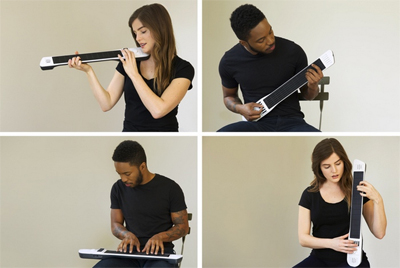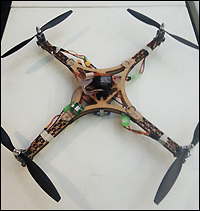Artiphon, a Nashville music technology startup with its “everything instrument,” has tapped two engineering student teams to tackle engineering challenges as their senior design projects.
Those teams join hundreds of Vanderbilt engineering seniors who have spent two semesters on projects. They all will demonstrate their readiness to tackle real-world engineering problems by showcasing their projects during the annual School of Engineering Design Day on Monday, April 20, 4-6 p.m. in Featheringill Hall.

Artiphon’s Instrument 1 is a customizable device that consists of a force-sensitive fretboard alongside a digital string-like interface and built-in speakers. It can mimic a violin, guitar, piano, drumset, or any number of other instruments, and can be played using the same motion – bowing, strumming, tapping or sliding. It works with any MIDI-compliant app.
Excitement over the instrument’s release is apparent, with media coverage in Wired, TechCrunch, The Verge and numerous other outlets. Even more impressive: Artiphon’s fund-raising success on Kickstarter, where a campaign to raise $75,000 yielded $1.32 million.
“People responded to our message of casual creativity,” said Ryan Wrenn, who worked as a research staff engineer with Vanderbilt’s Institute for Software Integrated Systems before becoming Artiphon’s CTO. “We have backers from all over the world that have been very supportive of what we’re doing.”
Wrenn said the company will be looking to hire Vanderbilt interns and graduates while fulfilling instrument orders placed through the Kickstarter campaign. For now, Artiphon is benefiting from engineering help through the senior design program.
A team of electrical engineering students worked on the instrument’s pressure and touch sensitive sensors, testing its current circuits and developing a computational model that predicts responses. Their “testing rig” automatically performs a force sweep and collects data that will be given to Artiphon for future use.
A mechanical engineering team fabricated physical overlays based on their computational models to test the plucks and presses on the instrument, which features a series of black fret touch-pads down the neck that replicate strings. They’ve stored the data in a software database with a graphical user interface to make the information easy to access. It is anticipated that Artiphon engineers will be able to use the data to execute design changes on overlay performance rather than manufacture multiple prototypes.
“This is the quintessential immersion experience,” said Tom Withrow, assistant professor of the practice of mechanical engineering and his department’s leader for Design Day. “Students embed inside a firm for awhile to get that experience.
“It gives them the wherewithal so they can look at the engineering they have to do to come up with a good design solution.”
Other corporate sponsors this year include Camgian Microsystems, DENSO, MAX Mobility, Northrop Grumman, Triumph Aerostructures and Vesalius Dynamics. Other sponsors include NASA, a number of Vanderbilt University Medical Center departments, and several area engineering firms. For the second year, AT&T will present its Innovation Award.
More than 60 projects by interdisciplinary teams in biomedical engineering, chemical engineering, civil engineering, computer engineering, electrical engineering, and mechanical engineering will be displayed throughout Featheringill Hall.
Students will install their presentations from 2-4 p.m, and a panel of jurors will review the projects.

“Senior design courses provide students with experience working on real-world projects that involve design constraints, budgets, reviews and deadlines. Students learn about professionalism, licensing, ethics, entrepreneurship and the day-to-day implications of intellectual property,” said Associate Dean Cynthia Paschal, who also serves as senior design coordinator. “Design Day is their showcase.”
One interdisciplinary team is creating a new, reasonably priced electromechanical portable pain pump that can deliver more accurate dosages of analgesics. After a major surgery such as a knee or hip replacement, patients need a local analgesic delivered through a catheter to the surgery site. While there are a number of portable pain pumps on the market, the students’ main improvement to a portable pump system is the addition of electrical components to regulate flow rate and a dosage capsule that provides accurate measurement of the analgesics.
Sponsored by Northrop Grumman, a five-student team has designed a compact quadcopter capable of establishing radio communication in situations where radio signals are blocked by terrain or urban structures. The quadcopter can carry a relay to a sufficient height in order to establish line-of-sight communication.

Simply disassembled, the quadcopter can fit in a backpack. During flight, a user can select a preset position based on GPS waypoints or use a transmitter to manually control the quadcopter. The folding frame, preset functions and parachute, which can be deployed manually or automatically in the event of a battery failure, render the quadcopter ideal for military use.
Three separate design teams worked on improving prosthetic devices.
One team focused on improving the fit of prosthetics in order to minimize pain or pressure points that may lead to neuropathy. They designed a removable elastomer strip containing force sensitive resistors that is inserted into a device’s socket. Data is gathered while standing and during full gate cycles. The output data allows a prosthetist to alter the device to alleviate pressure areas.
Two teams worked on prosthetic knee designs. Both focused on features that would allow for more strenuous multiple activities like running and bicycling for amputee athletes. The sponsor for all three teams is The Surgical Clinic, PLLC.

Students usually get to work on a project they prefer. “Occasionally, some get drafted,” said Barnett, associate professor of mechanical engineering and design faculty adviser. “If they end up working on something they don’t like at first or are unfamiliar with, well, we say, ‘Welcome to the real world of work.’”
“These projects often turn out to be some of the best, since the team is working in areas that are new to them,” he said.
Other 2014-2015 faculty advisers are Withrow and Bob Webster, mechanical engineering; Matthew Walker III, biomedical engineering; Ken Debelak, Russell Dunn and Scott Guelcher, chemical and biomolecular engineering; Sanjiv Gokhale, civil engineering; Ralph Bruce, electrical engineering; and Jules White, computer science.
Contact:
Brenda Ellis, (615) 343-6314
Brenda.Ellis@Vanderbilt.edu
Twitter @VUEngineering